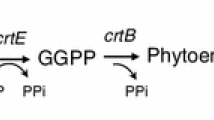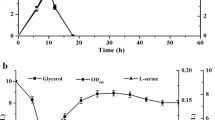Abstract
In the fed-batch culture of glycerol using a metabolically engineered strain of Escherichia coli, supplementation with glucose as an auxiliary carbon source increased lycopene production due to a significant increase in cell mass, despite a reduction in specific lycopene content. l-Arabinose supplementation increased lycopene production due to increases in cell mass and specific lycopene content. Supplementation with both glucose and l-arabinose increased lycopene production significantly due to the synergistic effect of the two sugars. Cell growth by the consumption of carbon sources was related to endogenous metabolism in the host E. coli. Supplementation with l-arabinose stimulated only the mevalonate pathway for lycopene biosynthesis and supplementation with both glucose and l-arabinose stimulated synergistically only the mevalonate pathway. In the fed-batch culture of glycerol with 10 g l−1 glucose and 7.5 g l−1 l-arabinose, the cell mass, lycopene concentration, specific lycopene content, and lycopene productivity after 34 h were 42 g l−1, 1,350 mg l−1, 32 mg g cells−1, and 40 mg l−1 h−1, respectively. These values were 3.9-, 7.1-, 1.9-, and 11.7-fold higher than those without the auxiliary carbon sources, respectively. This is the highest reported concentration and productivity of lycopene.






Similar content being viewed by others
References
Alper H, Miyaoku K, Stephanopoulos G (2005) Construction of lycopene-overproducing E. coli strains by combining systematic and combinatorial gene knockout targets. Nat Biotechnol 23:612–616
Alper H, Miyaoku K, Stephanopoulos G (2006) Characterization of lycopene-overproducing E. coli strains in high cell density fermentations. Appl Microbiol Biotechnol 72:968–974
Ansari MS, Gupta NP (2004) Lycopene: a novel drug therapy in hormone refractory metastatic prostate cancer. Urol Oncol 22:415–420
Bhataya A, Schmidt-Dannert C, Lee PC (2009) Metabolic engineering of Pichia pastoris X-33 for lycopene production. Process Biochem 44:1095–1102
Bignotto L, Rocha J, Sepodes B, Eduardo-Figueira M, Pinto R, Chaud M, de Carvalho J, Moreno H Jr, Mota-Filipe H (2009) Anti-inflammatory effect of lycopene on carrageenan-induced paw oedema and hepatic ischaemia-reperfusion in the rat. Br J Nutr 102:126–133
Bramley PM (2000) Is lycopene beneficial to human health? Phytochemistry 54:233–236
Choudhari SM, Ananthanarayan L, Singhal RS (2008) Use of metabolic stimulators and inhibitors for enhanced production of beta-carotene and lycopene by Blakeslea trispora NRRL 2895 and 2896. Bioresour Technol 99:3166–3173
Clinton SK (1998) Lycopene: chemistry, biology, and implications for human health and disease. Nutr Rev 56:35–51
Erdman JW Jr, Ford NA, Lindshield BL (2009) Are the health attributes of lycopene related to its antioxidant function? Arch Biochem Biophys 483:229–235
Fang A, Demain AL (1997) Influence of aeration and carbon source on production of microcin B17 by Escherichia coli ZK650. Appl Microbiol Biotechnol 47:547–553
Farmer WR, Liao JC (2000) Improving lycopene production in Escherichia coli by engineering metabolic control. Nat Biotechnol 18:533–537
Giovannucci E (2002) A review of epidemiologic studies of tomatoes, lycopene, and prostate cancer. Exp Biol Med (Maywood) 227:852–859
Jin YS, Stephanopoulos G (2007) Multi-dimensional gene target search for improving lycopene biosynthesis in Escherichia coli. Metab Eng 9:337–347
Kerr S, Cale C, Cabral JM, van Keulen F (2004) Factors enhancing lycopene production by a new Mycobacterium aurum mutant. Biotechnol Lett 26:103–108
Kim SW, Kim JB, Ryu JM, Jung JK, Kim JH (2009) High-level production of lycopene in metabolically engineered E. coli. Process Biochem 44:899–905
Korz DJ, Rinas U, Hellmuth K, Sanders EA, Deckwer WD (1995) Simple fed-batch technique for high cell density cultivation of Escherichia coli. J Biotechnol 39:59–65
Lee PC, Mijts BN, Schmidt-Dannert C (2004) Investigation of factors influencing production of the monocyclic carotenoid torulene in metabolically engineered Escherichia coli. Appl Microbiol Biotechnol 65:538–546
Lendenmann U, Snozzi M, Egli T (2000) Growth kinetics of Escherichia coli with galactose and several other sugars in carbon-limited chemostat culture. Can J Microbiol 46:72–80
Mantzouridou F, Tsimidou MZ (2008) Lycopene formation in Blakeslea trispora. Chemical aspects of a bioprocess. Trends Food Sci Technol 19:363–371
Martin VJ, Yoshikuni Y, Keasling JD (2001) The in vivo synthesis of plant sesquiterpenes by Escherichia coli. Biotechnol Bioeng 75:497–503
Michael McClain R, Bausch J (2003) Summary of safety studies conducted with synthetic lycopene. Regul Toxicol Pharmacol 37:274–285
Nicolas-Molina FE, Navarro E, Ruiz-Vazquez RM (2008) Lycopene over-accumulation by disruption of the negative regulator gene crgA in Mucor circinelloides. Appl Microbiol Biotechnol 78:131–137
Tereshina VM, Memorskaya AS, Feofilova EP (2010) Lipid composition of the mucoraceous fungus Blakeslea trispora under lycopene formation-stimulating conditions. Microbiology 79:34–39
Yoon SH, Lee YM, Kim JE, Lee SH, Lee JH, Kim JY, Jung KH, Shin YC, Keasling JD, Kim SW (2006) Enhanced lycopene production in Escherichia coli engineered to synthesize isopentenyl diphosphate and dimethylallyl diphosphate from mevalonate. Biotechnol Bioeng 94:1025–1032
Yoon SH, Park HM, Kim JE, Lee SH, Choi MS, Kim JY, Oh DK, Keasling JD, Kim SW (2007) Increased beta-carotene production in recombinant Escherichia coli harboring an engineered isoprenoid precursor pathway with mevalonate addition. Biotechnol Prog 23:599–605
Yoon SH, Lee SH, Das A, Ryu HK, Jang HJ, Kim JY, Oh DK, Keasling JD, Kim SW (2009) Combinatorial expression of bacterial whole mevalonate pathway for the production of beta-carotene in E. coli. J Biotechnol 140:218–226
Acknowledgment
This study was supported by a grant (2009-0084490) from the Basic Research Program, Ministry of Education, Science and Technology.
Author information
Authors and Affiliations
Corresponding author
Rights and permissions
About this article
Cite this article
Kim, YS., Lee, JH., Kim, NH. et al. Increase of lycopene production by supplementing auxiliary carbon sources in metabolically engineered Escherichia coli . Appl Microbiol Biotechnol 90, 489–497 (2011). https://doi.org/10.1007/s00253-011-3091-z
Received:
Revised:
Accepted:
Published:
Issue Date:
DOI: https://doi.org/10.1007/s00253-011-3091-z




